Speed \u200b\u200bhas long beckoned people and forced them not to stop there. A little more than a hundred years ago, drivers at a speed of 30 km / h were called madness, and today's race cars easily develop 10 times greater performance and even swing at a line of 400 km / h! Of course, to buy such cars is not easy enough - most of the racing equipment is available only to the richest people in the world. Some cars and all that is a reason for special pride of their owners. What modern race cars are considered the best - we will try to give an answer to this question by compiling a speed rating.
1st place - SSC Tuatara
The race car, considered the world leader, has not yet been put on open sale and has not set a single official record. However, Shelby (SSC) claims that its car under the unusual name Tuatara can reach speeds of up to 443 km / h. In addition, a figure of 2.5 seconds is also called, during which the car reaches 100 km / h, but there are no other data on the dynamics. But the characteristics of the motor were announced back in 2011 at the presentation of the prototype. The aluminum V8 with a volume of 7 liters was borrowed from Ford, and the installation of two turbochargers made it possible to increase its power to 1350 horsepower.
Carbon will be widely used in the race car - the body, engine mounts, brake system components and even rims are made from it. It is supposed to use a seven-speed “mechanics” as a transmission, which can be equipped with robotic control upon request. It is clear that such a racing car can be equipped with all conceivable electronics, starting from the multimedia center and ending with cameras instead of rear-view mirrors. The start of sales of the car was scheduled for 2013, but for several years it has been postponed for unnamed reasons.
2 Place - Bugatti Veyron SS
The official serial car belongs to the famous Bugatti veyronor rather, its improved Super Sport modification. After a series of test races conducted according to international rules, the speed of the racing car was 431 km / h, which allowed him to get the championship title. However, cars on sale accelerate to 415 km / h, which is associated with a high risk of damage to equipment at high rates.
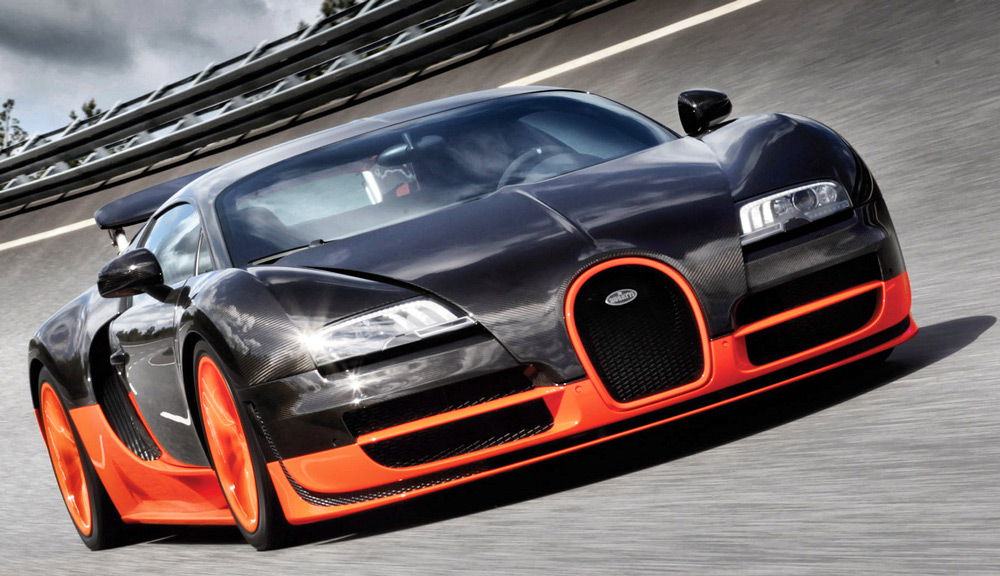
Speed, like beauty, requires sacrifice - with dynamic movement, the average fuel consumption of a racing car is 55-60 l / 100 km. In addition, during the season the car can wear several sets of exclusive tires, each of which is estimated at 30 thousand dollars. And Bugatti racing cars cannot drive for a long time at maximum speed. The permitted mileage at a speed of 400 km / h is 60 kilometers, after which the car must be slowed down to 250 km / h to cool the tires and the brake system.
3rd place - Hennessey Venom GT
The American tuning studio Hennessey has created a truly unthinkable combination by installing the huge Chevrolet Corvette V8 in the tiny body of the English sports car Lotus Exige. The installation of two turbines allowed to increase the power of the racing car to 1200 horsepower, and to increase the top speed to almost 428 km / h. Of course, this is slightly less than that of Veyron, but the Americans abandoned the speed limiter and therefore on a normal road, rather than a closed test site, their car can be considered the fastest in the world.
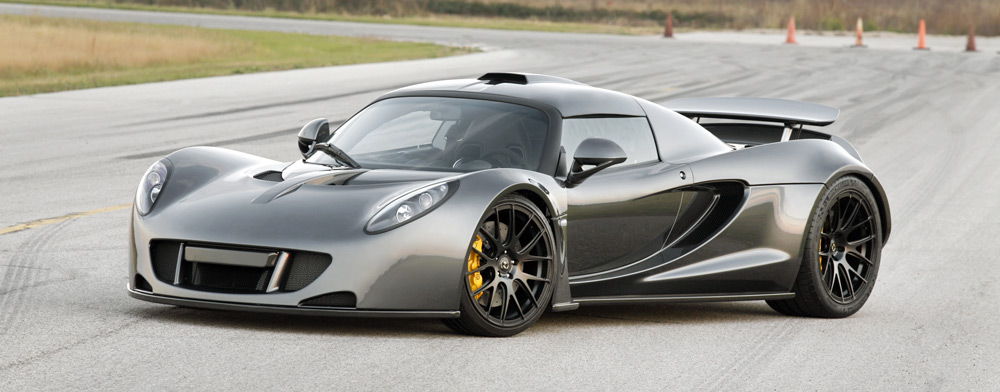
The rear-wheel-drive racing car is available in two versions - a convertible and a roadster with a removable plastic roof. In addition, three cars were produced in a special coloring dedicated to the established world record. Of course, the champion title was lost, but Hennessey is already preparing for a rematch. Soon the world will see the updated race car, the engine power of which will be increased by 200 horsepower.
4th place - Koenigsegg Agera R
Despite everything, the Swedes claim that the speed record belongs to them, because their supercar Koenigsegg Agera R shows better results than all the cars mentioned above. The company provided data according to which the average speed of a racing car was 440 km / h in some races, and the highest recorded rate was 453 km / h! However, official confirmation is not yet available, as the company has not submitted an application to the international motorsport federation. Therefore, the technical parameters indicate the indicator 410 km / h, which the car achieved in certification tests. True, the parameters known to the general public make one doubt the record status of the car - its power is 1115 horsepower, and acceleration to 100 km / h takes 2.9 seconds compared to 2.2 for the Venom GT and 2.5 for the Veyron SS.

Agera R is also included in the rating due to the use of exclusive materials. When creating the body, carbon was abundantly used, from which some body panels, a body kit, a wing and wheel disks of a racing car were made. The salon is manually trimmed with expensive leather used in. The list of used electronics includes a complex that controls all car systems, modern multimedia and all active safety equipment known in the automotive industry.
5th place - SSC Ultimate Aero TT
This car is already a very real means of transportation, and not a concept that has been exhibited at various exhibitions for dozens of times. For a long time, it was her who owned the record for the speed of road transport, until the race cars discussed above appeared. is 412 km / h, and acceleration to the first "hundred" takes only 2.8 seconds. True, the engine develops a power of 1183 horsepower exclusively when refueling the car with fuel provided by the manufacturer. If you fill in the usual “ninety-eighth” tank, the performance will drop to 900 horsepower and the car will not be able to reach the milestone of 400 km / h.
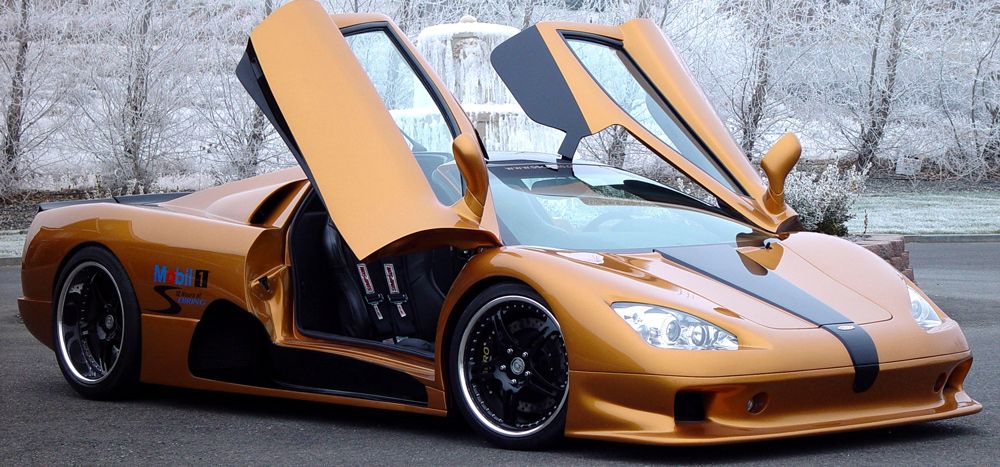
Compared to most record-breaking supercars, the car can be considered quite comfortable. The cabin has comfortable seats, not sports “buckets,” and a multimedia system can play videos and delight the owner’s hearing with excellent sound quality coming from twelve speakers. The car is available to order today, however, it is produced during the year by reservation with full payment.
6th place - Koenigsegg CCX-R
This car of a young Swedish company may also have problems with fuel - however, it does not require high-octane gasoline, but bioethanol, which is not very popular in Europe yet. When refueling with environmentally friendly fuel, a racing car equal to 1018 horsepower and accelerates to 402 km / h. A-95 gasoline can also be used as a backup source of energy, but power will automatically decrease to 806 horsepower, and maximum speed - up to 358 km / h. Car caught in topIt is also interesting for its low fuel consumption - with uniform movement at a speed of up to 300 km / h it is only 22 l / 100 km. However, the "full throttle" increases this figure to almost 50 liters, so the power reserve of the sports car is very limited.
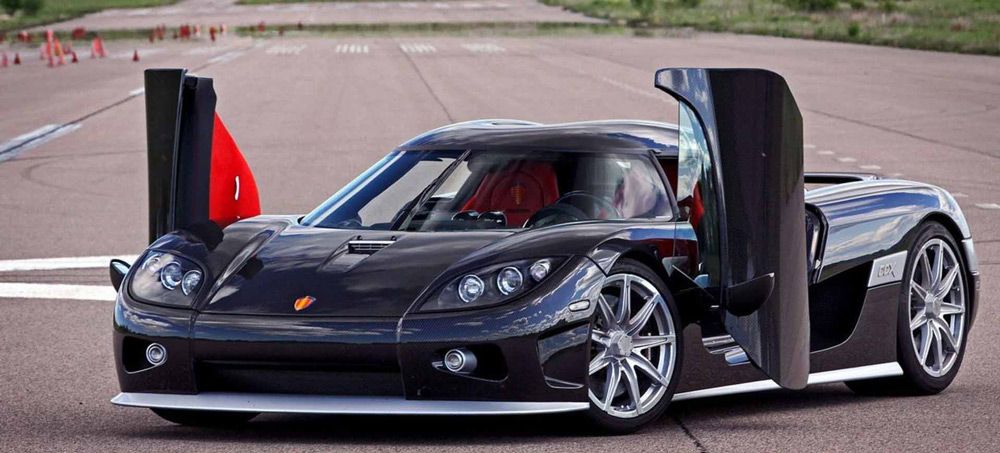
In its technical structure, the Koenigsegg CCX-R is most similar to an ordinary passenger car. Its engine has a capacity of only 4.7 liters and is built on the basis of a conventional Ford power unit, originally not intended for motorsport. The body of the race car is made of aluminum, not plastic, and can be restored after a small accident. However, the company also produced special modifications to the car, which were equipped with a carbon body with a diamond coating. Now the race car is discontinued, but one of its special versions can be assembled by special order.
The best of the best
In terms of their parameters, the fastest racing cars outperform conventional vehicles, which makes their owners feel superior. However, such cars can not be called the most desirable among collectors, since they appreciate such rare sports cars as:
- Lamborghini Miura;
- Mercedes 300 SL;
- Ferrari Testarossa;
- Jaguar XK 200.
Each of the aforementioned racing cars of previous years has historical value, which will appear in modern supercars in only a few decades. In addition, they cannot be called the fastest either, since there are faster vehicles in the world on which official speed records were set. Therefore, while modern racing cars are expensive toys designed for rare trips to the track.
The best prices and conditions for the purchase of new cars
Credit 4.5% / Installments / Trade-in / 95% approvals / Gifts in the salonMas Motors
The GL-1 car at the head of the column of new cars at the Gorky Automobile Plant, on May 1, 1938, will be a tankman tomorrow! ” In 1938, at the Gorky Automobile Plant. Molotov created a record racing car GL-1. He became the first Soviet race car, designed and built not by artisan enthusiasts, but by specialists of an automobile factory. Record-racing car GL-1 at the start.
GAZ also responded to the call of the USSR government to car factories about the creation of racing cars. The initiator of these works was the chief designer of the plant Andrei Aleksandrovich Lipgart. Like no one else, he understood the importance of building race cars and participating in sports. The desire to be the first spurred the design idea, and in high-speed races, automobile units passed accelerated tests for operability and reliability. Participation in car racing for the plant was not an end in itself - motor sport made it possible to quickly search and find the optimal design of many units and immediately try them in action.
They say that the record-racing car with the GL-1 index, created in 1938, was deciphered as “Racing Lipgart first.” If so, then this is a curtsy in the direction of the chief designer, a sign of respect for his foresight and determination. After all, GL-1 was the first Soviet race car designed and built by a car factory, and not amateur athletes in taxis parks, garages or club design bureaus.
The base was taken from the famous GAZ M-1, or rather, during the construction, its chassis was used, "dressed" in an open double body. Wings, steps, headlights - all removed.
Design a race car A.A. Lipgart instructed a talented designer, the head of the experimental workshop of GAZ Evgeny Viktorovich Agitov. A former combat pilot of the tsarist army, Agitov came to the plant in September 1929 after graduating from the Leningrad Institute of Labor and six months later headed the experimental workshop. And in September 1933, A.A., who arrived from Moscow, was appointed to the post of chief designer of GAZ. Lipgart. He discerned an outstanding specialist in Agitov and made him his first and only deputy.
On the chassis of the serial "emka" Agitov put a double open body streamlined, which did not have wings, doors, steps and headlights. All this made the car heavier and prevented the achievement of the main goal - the establishment of a speed record. The "stripped" car began to weigh exactly a ton instead of almost one and a half tons of a serial "emka". The standard GAZ-M1 four-cylinder engine with an experimental cylinder head was boosted according to Ford documentation, which by that time had been thoroughly studied and mastered at GAZ. Increases in power were achieved by increasing the degree of compression, speed and size of the valves. Two carburetors were installed on the motor, and the inlet and exhaust manifold pipes were polished from the inside. These measures led to the fact that, unlike a standard engine with a capacity of 50 hp its racing version was already producing 65 hp. at 3200 rpm This was the limit of capabilities of the four-cylinder power unit. More than Agitov was able to do, no one achieved the M1 engine. The first official launch of the GL-1 was given in September 1938 on the Zhytomyr Highway near Kiev, at 11 All-Union Auto-Moto Competitions. More than two hundred athletes from thirty cities gathered for the championship of the USSR, however, motorcyclists made up the main backbone. Leningrad race car drivers A. Gerel, G. Kleschev and G. Tsvetkov, who already had experience in such competitions, arrived in their cars. On their account were the first set records. 24-year-old test technician of the road test department of KEO GAZ Arkady Nikolaev was to perform in a Gorky race car. The mechanic Mikhail Smirnov was engaged in servicing the car at the competitions.
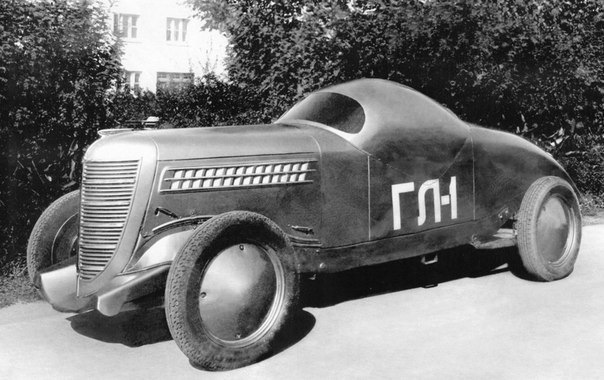
Agitov continued to improve the Soviet sports car and in 1940 the car received a GAZ-11 six-cylinder (3485 cm ") engine.
Engine: number of cylinders: - 6, displacement - 3485 cm3, number of carburetors - 2, valve mechanism - SV, power - about 100 l. from. at 3600 rpm; the number of gears - 3; tire size - 6.50-16 inches; curb weight - about 1100 kg; base - 2845 mm; maximum speed - 162 km / h; travel time 1000 m from standstill - 35.5 s.
At the same time in Europe, and more precisely in Germany, work was also underway to create the fastest racing car in the world. Ferdinand Porsche himself worked on the Silver Arrows, entering into fierce competition with the engineers of Mercedes.
While trying to overcome the speed of 147 km / h at GAZ, in Germany, not far from Nyururgring, joint races of Autounion and Mercedes were held.
The factory test of GAZ was Arkady Nikolaev. At the first race in Kiev (1938), a speed of 143 km / h was achieved. In Moscow, this tester accelerated the car to 147 km / h
... The Second World War in its own way ordered the construction of racing cars. Those few copies of the GAZ GL-1, which were created in the 1938-40s as experimental samples, were destroyed under certain circumstances during the Second World War. According to one version, they were cut at the factory, like many cars that did not go into series. On the other - destroyed during one of the bombing of GAZ. But the car did not reach mass production due to the fact that it had not yet been brought to the desired state.
After the war, Arkady Nikolaev realized himself as a scientist. He took part in many secret state projects, the most striking of which is a successful expedition to the pole of inaccessibility of Antarctica.
The fate of Yevgeny Agitov was tragic. The projects on which he worked were “frozen” during the war, and the designer committed suicide.
In the 70s, the artist Alexander Zakharov again returned to the theme of GL-1 and traced it in detail from existing photographs. And in 2006, the workshop of Alexander Bushuev begins to recreate the car live.
workshop of Alexander Bushuev
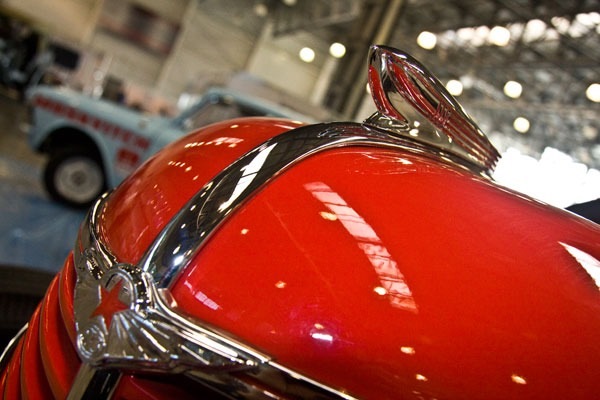
CAR SPORTS. Soon after the creation, at the end of the 19th century, of the first commercial vehicles, drivers began to look for ways to organize automobile competitions. Car racing over time has become a very attractive sport for spectators.
ADMINISTRATIVE BODIES
The international regulator for motor sports is the International Automobile Federation (FIA), with its headquarters in Paris (France). The FIA \u200b\u200bwas founded in 1904. Car racing in individual countries is usually controlled by national automobile clubs that are members of the FIA. For example, in the USA, five major organizations conduct surveillance of automobile competitions: the United States Auto Club (USAC), the American Club sports cars (the Sports Car Club of America - SCCA), the International Motor Sports Association (IMSA), the National Association for Stock Car Auto Racing - NASCAR, and the National Hot Racing Association Rod Association - NHRA).
RACING
There are three main types of race tracks: oval tracks, highway tracks and straight tracks.
The tracks are oval. The base track lengths are 200, 400, 800, 1600 and 4000 m or more. Tracks with a length of 200, 400 and 800 m are either cinder or asphalt. All longer tracks are asphalt. Most of the one-mile (1600 m) tracks are flat with slightly inclined turns. Turns on longer tracks are either slightly or steeply inclined. The shape of the longer tracks may approach a rectangular, or D-shaped, like the track for international competitions in Dayton (Florida).
Highways. Road races were originally held on public roads. However, now most of the road racing is held on specialized racing circuit tracks; The main exceptions to this rule are races in the Grand Prix draw system along the streets of Monte Carlo (Monaco) and Long Beach (California). Most highways are laid in accordance with the terrain; a small number of such tracks have a completely flat shape. Some specialized road racing tracks pass, wriggling heavily, through the countryside.
Direct tracks. Short straight tracks called speed lanes can only be 400 meters long. Two of the most famous speed lanes are Raceway Park in Indianapolis and the Orange County International Speedway 80 km south of Los Angeles (California). Another type of completely straight trails is used for races to set a speed record. Similar tracks can be up to 16 km long. The most famous of these trails is laid along the dry section of the salt lake Bonneville in pc. Utah.
RACING CARS
There are four main types of racing cars: open-wheel, serial, sports-type and dragsters (for speed racing on short straight tracks). (The word "dragster" ("tractor") is derived from the English verb drag - pull, overcome resistance.)
Cars with open wheels. On an international scale, Formula 1 or Grand Prix open-wheel racing cars are best known. Built and operated to standards close to those set by the FIA, Formula 1 cars are based on a monocoque chassis, independent suspension, have a recess in the center for the rider, lying on his back, and an engine installed immediately behind the rider. Usually a 4- or 6-cylinder engine is used, each of which develops power up to 1200 hp. in qualification tests. Both types of engines are purely racing, however, by design principle, they are similar to any serial engine and can accelerate the car to a speed of 360 km / h.
Weighing approximately 600 kg, Formula 1 cars compete only on highways, as do several other smaller types of open-wheel vehicles. But the latest cars, which are often used to train riders in Formula 1 competitions, are equipped with modified serial engines, such as, for example, the 5-liter Chevrolet V-8 engine. The Formula 2 car in shape is a 4/3 times reduced Grand Prix class car and has a 2 liter racing engine. The next, one step lower class, is made up of Formula 3 cars with a modified 2-liter serial engine and narrower tires. A 1.6-liter Ford engine is installed on Formula Ford cars, and a 1.2-liter Volkswagen engine on Formula Vee cars.
Championship or Championship cars are also equipped with open wheels. They compete almost exclusively on oval tracks at least 1.6 km long. Although Championship-class cars may look like Formula 1 cars, they are slightly larger and heavier. Almost 2.64-liter turbocharged engines are installed on almost all of these vehicles, developing power up to 850 hp. on fuel mixtures of a special composition. In engines with a large displacement, turbocharging cannot be carried out. The maximum speed of cars of this class is close to 368 km / h.
Sprint cars, similar to Championship cars, are only available in the United States. Repeating the traditions of designing the period before the Second World War, these cars have a very straightened and high lining, in contrast, for example, from low-sitting cars of the "Indy" class, in which the rider occupies an almost horizontal position lying on his back. Sprint-class cars, which typically have a modified 550-horsepower Chevrolet serial engine, are very dangerous to drive. While the driver of an indie car seeks to maintain direction and maintain maximum speed, a good sprint car driver has to throw his car from side to side most of the competition time. Racing on 730 kg sprint cars, conducted on cinder or asphalt tracks up to 1.6 km long, is one of the most exciting types of car racing.
Subcompact racing cars look like Sprint cars in miniature. 4-cylinder engines are installed on these cars, but racing on them is an equally spectacular sight. Three-quarter (TQ) subcompacts are even smaller.
Production cars. While Formula 1 and Indianapolis class cars are purely racing, production cars are consumer cars modified for racing. Often, not many details of a consumer car are preserved after such a modification, however, the aerodynamic drag of a car of this type imposes certain critical restrictions on the capabilities of an engineer creating a racing car on its basis. The creator of the production car begins its work by disassembling a consumer car. Then he transforms the standard engine into a racing one, strengthens the design of the car so that it can withstand the loads of racing, and installs a massive steel frame inside the body to protect the driver in case of an accident. At NASCAR, such remodeled cars are called production cars of the Grand National class. There are other types of production cars - some of them are as new and well finished as the excellently assembled Grand National cars; others are more like a giant open-wheel racing car fitted with a standard body than a regular consumer car. Racing on production cars held in many countries around the world, from the United States and Great Britain to countries such as Argentina and Australia.
It is difficult to imagine modern mankind without cars, in particular without racing models. An unusual and fascinating sight is the “flight” of cars along tracks of varying complexity and length. Racers participate in breathtaking competitions such as rally, karting, and different kinds racing. Having plunged into the period of the birth of the automotive industry, we will find out how and when the first racing car in the world appeared and what difficulties the inventors had to go through before creating the ideal model for racing.
The first competition that opened the possibility of the appearance of racing cars
Interestingly, the history of racing cars began during the period of world motorization. In 1894, the first automobile competitions were held in France, the route was chosen from Paris to Rouen. The total length was 127 km. The resourceful chief editor of the local newspaper published an official invitation for everyone to participate in the "Horseless Carriage Competition." The main prize for the winners was 5,000 francs. A prerequisite for all teams was to comply with a speed of about 10 km / h. It is noteworthy that not only the maximum speed was the main criterion for victory, but also such characteristics of transport as: maneuverability and ease of control, aesthetic appearance, reliability and, at the same time, simplicity of design.
According to the results of the race, two teams won at the same time, having developed a speed of 12 km / h with a power of 2.5 hp. It is these two models that actually became the first racing cars in the world. These were the Panar Levassor and Peugeot. Currently, there are disputes as to whether the victory went to two teams or only one. The fact is that “Panar-Levassor” was not 4-seater, as the conditions of the competition demanded, but only 2-seater.
In any case, the 1894 race is not considered official due to speed limits and fuzzy criteria for choosing a winner.
It was France that launched the development of auto sports. She became the center of the competition. However, races quickly spread beyond its borders, for example, in cities such as: Amsterdam, Vienna, Berlin, etc. After participating in races became prestigious and fashionable, similar events began to be held very often (up to 30 competitions per year for to the whole world).
The first official racing car in the world.
In 1895, regular races took place in France, the winner of which was the Panar-Levassor team and its leader Emile Levassor. During the passage of a difficult route with a total length of 1,200 km, the car moved at a speed of 24.5 km / h (which was 2 times faster than the speed and 10 times the total length of the route, compared to the previous race). The winner covered the distance in just 48 hours.
The first Michelin tires were spotted precisely at the 1895 race. However, they were imperfect and required frequent replacement so that the participants in this team had to leave the race. After all, they could not meet the allotted time for the race - 100 hours.
The first race cars in the USSR
The first Russian auto racing took place long before the advent of Soviet racing cars - in 1898 near St. Petersburg. The event was attended by very few people: either because of bad weather, or because of the insufficient popularity of auto racing at that time in the USSR.

ZIS-101A-Sport
GAZ-GL1 and ZIS-101A-Sport are considered pioneers among Soviet race cars. Models were assembled at the Moscow Automobile Plant in the 30s. Of course, at that time there were no basic concepts of aerodynamics and design of sports cars. However, Soviet cars had an extremely high speed at that time - 150-160 km / h. For comparison, the maximum speed of mass-produced cars was 125 km / h.
It's no secret to anyone how dangerous car racing is. Participants deserve special respect for their courage and strength.
Many great racing cars have appeared in the world. From time to time, a car appears that inspires the world of sports for years to come. The glory of the exploits of these fireballs and the riders who drove them remains for centuries. Films are made about them, I write stories, betray historical facts by word of mouth. Over the long history of motor sports, racing cars have repeatedly appeared that were innovative, excellent, beautiful or iconic.
Formula 1, DTM, Rally - each of the different types had their own iconic cars, the ingenious inventions of engineering have no limits. We present to our readers the site of 10 cars, which, we assume, are the most legendary in the world of racing. We consider rating them to be a futile exercise, it is impossible to compare them, since their importance is directly related to the various disciplines of motorsport.
Let's leave it as it is, just state the facts and present the Top 10 most legendary of all time in alphabetical order.
Audi Sport Quattro S1 E2
In the early 1980s, Audi largely dominated rally racing with its various versions of Quattro race cars, although the A1, A2 and Sport Quattro were formidable cars for their rivals, the Audi Quattro S1 E2 crowned rally efforts.
Possessing a 2.1 liter turbocharged five-cylinder engine that “made” 470 hp, the S1 E2 was a real monster outgrowth of the legendary rally Group B, which managed to take the art of rally to a new level. If it weren’t enough, the madmen from the "rocked" their ward to 600 hp. Probably a sign from above was the Group B ban, which did not allow this rally heavyweight to enter the competition.
Auto Union Type C / D Hill Climb and Type C Streamliner
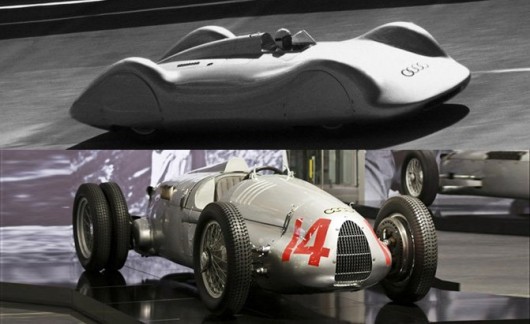
In the mid 30-ies of the XX century, Auto Union (which included) conducted a successful Grand Prix program, in which Type A, B, C and D race cars participated. These cars were unusual for that time due to the mid-central engine location. Type A, B and C cars came with a 16-cylinder engine, Type D was distinguished by a more modest 12-cylinder block.
Of the total number of unusual Auto Union, two special Auto Union Type cars are distinguished. First of all, it was a fully streamlined model. Built on the basis of Type C, the Streamliner was designed to maximize the benefits of the 560 strong Type C engine. When testing the car for the Grand Prix on the Autobahn (yes, you read it right, didn’t bother with safety then, set speed records, straight on public roads), Streamliner reached 400 km / h, and this is in 1937!
The following year, the same crazy engineers decided to build a Type D racing with a Type C engine for hill-climbing racing. So that all the gigantic power would surely go into asphalt, the car was equipped with a set of dual tires, which were installed on each side in the rear of the car.
Chaparral 2j

In the wild world of Can-Am racing, Chaparral has revised its standard approaches to gain an edge over all rivals. On previous models of the company's racing cars, massive aerodynamic wings were used for this, later engineers decided to have fun to the fullest. Chaparral came up with a witty way to get the optimum downforce, regardless of the speed at which her new 2J car was driving. He “stuck” to the canvas using a vacuum.
Two fans were installed in the rear of the car, they were driven by a snowmobile engine, and they sucked in air from under the bottom of the car. Skirts on the sides of the car, constantly located one inch from the ground due to the special design of the suspension. The 2J really had a good downforce. In this, he circumvented many of his competitors, but 2J was terribly unreliable and subsequently banned from racing for one year.
Ford gt40
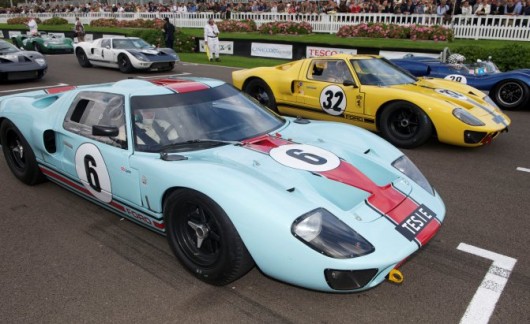
The history of races is developing continuously, and at each stage of development we can observe our superheroes among cars. We will probably never be able to forget some. One of them has become. The supercar was conceived after Ford's unsuccessful attempt to acquire a Ferrari. The GT40 was built to knock Ferrari out of their own endurance racing game. By 1966, the task was achieved, the GT40 finished 1, 2 and 3 in the legendary 24 hour Le Mans race. The GT40 will win over the next three years.
Four different versions of the GT40 were made: Mark I, II, III, and IV. Mark I used a 4.9-liter V8 from Ford, while Mark II, III and IV became the owners of the large 7.0-liter V8. To this day, the appearance of the GT40 is one of the most recognizable in the history of motorsport.
Lancia stratos hf
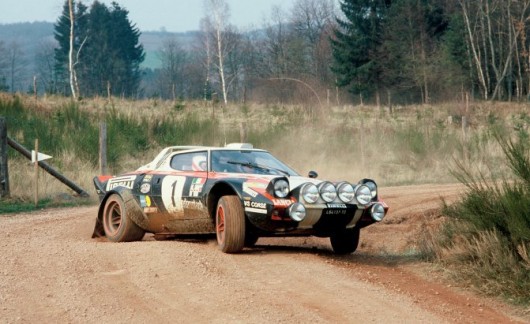
In the 1970s, Lancia began a partnership with Bertone to create a new rally car. To get maximum traction on the rear wheels, Lancia came to the conclusion about using an exotic layout with a centrally located engine. In the center of the Stratos HF, a 2.4-liter V6 borrowed from the Ferrari Dino was installed.
More like a rally car, the Stratos HF was very successful in rally racing. He won the World Rally Championship in 1974, 1975 and 1976. Although the other Lancia gained even more success in the rally ten years later, it did not have the same visual effect that the Stratos HF was able to achieve.
Mazda 787B

Over the years, many cars have won the Le Mans podiums and only a few have been able to do this several times. So what makes the 787B so special? This is the classic story of a loser who won. First of all, the 787B is the only Japanese car to ever win the 24-hour Le Mans race. To this day, much more powerful Japanese manufacturers such as Toyota, Nissan or Honda have not been able to repeat this feat.
Secondly, the Mazda 787B is the only car to win at Le Mans. The four-rotor motor was not only an excellent weapon of victory, but sounded like a paradise harp. The 787B was not the fastest car on Le Mans, but it won due to its reliability and excellent fuel consumption, it was economical. Yes, it owed its victory to reliability and profitability, power in racing cars is not the main thing.
McLaren MP4 / 4

In 1988, perhaps the best racing duo in the history of Formula 1 was formed. It was the year that Iron Senna joined Alain Prost on the team. In the same year, Honda became the engine supplier for McLaren, installing a 1.5-liter turbocharged engine in the new McLaren MP4 / 4.
To say that McLaren dominated the 1988 season would be an understatement. Of the 16 races that took place that year, McLaren took 15 pole positions and won 15 races! Senna, Prost and new to McLaren, Gerhard Berger, will continue winning races over the next few years. But none of the Marlboro-colored cars that follow the M4 / 4 will dominate the race.
Porsche 917

Porsche 917 is an unusual car, because he achieved success in two. Originally designed for endurance racing, the 917 has become a participant in many races such as the 24 hours of Le Mans. 917 secured success by winning the legendary race in 1970 and 1971, however, 1972 presented the race car with an unpleasant surprise, the rules of Le Mans changed, which automatically made the 917 obsolete.
Instead of throwing the car into the back of a racing story, Porsche turned its attention to the Can-Am racing series. Adding a turbocharger to its large V12, the 917 began to produce around 850 hp. and surprisingly won the new 1972 championship. In 1973, the engine was increased and now 917 could “produce” 1,500 hp. The car completely dominated in the next season, but the change in Can-Am rule in 1974, once again indicated the Porsche 917's place in racing history.
But in the memory of fans, he did not move to a landfill, on the contrary, he went to the Museum of Glory. Many believe that the Porsche 917 1973 is the most powerful racing car ever.
Suzuki Escudo Dirt Trail

Competitions Pike Peak International Hill Climb is an amazing thing. In racing uphill Pike Peak there are essentially no forbidden tricks, competitors can compete with each other as they please. Competition allows drivers, engineers and manufacturers to reach the limits of automotive engineering and technology. From 1992 to 2011, Nobuhiro “Monster” Taima dominated the climb and won the tournament nine times, including six times in a row, from 2004 to 2011.
Conceived as an idea in 1995. The car was named Suzuki Escudo Dirt Trail, the car became the owner of two turbocharged 2.5-liter V6 engines - one installed in the front, the other in the rear of the car. Total power - 981 hp Power went to all four wheels. , created all the downforce known to mankind, Escudo was a monster made to control the monster. He may not be the most fast carthat ever stormed a hill, but it's just one of the craziest stormtroopers.
The cementing foundation of the legacy was the inclusion of the Suzuki Escudo Dirt Trail in the Gran Turismo franchise.
Tyrrell P34
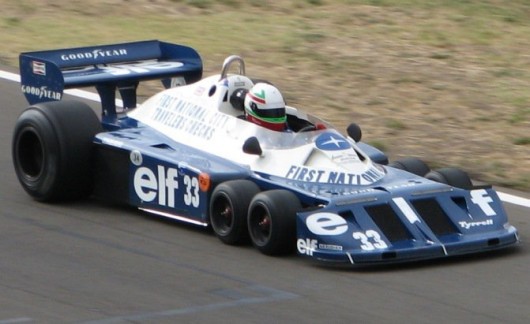
How to get more grip during racing Very simple - add wheels. Along with the enormous size of the rear wheels, the main distinguishing feature of the Tyrrell P34 are four small front wheels. This strange move at first glance could not only reduce drag and increase the front contact spot, but also allowed it to “acquire” additional braking force.
Prepared for the 1976 racing season, the six-wheeled mutant proved his competence in racing by being on the podium 10 times. He even won the Swedish Grand Prix that same year with an impressive finish for Tyrrell in 1st and 2nd places. In 1977, the car abruptly receded into the background, and advances in aerodynamics made the six-wheeled design redundant from the 1978 season.
Six wheels becoming Tyrrell's hallmark made him one of the most recognizable cars in motorsport, however, failed to make him the most productive.


